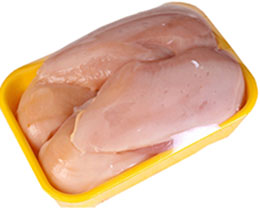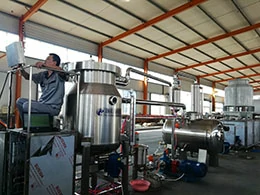Packaging can increase the shelf life of poultry meat; however, it cannot improve the quality of the product. Thus, good manufacturing and handling practices must be used to maintain a high quality packaged product.
Fresh Poultry Vacuum And Modified Atmosphere Packaging (MAP) Practise
Raw poultry meat is highly perishable even when stored under chilled conditions. The growth of psychotropic spoilage bacteria is most often the cause of spoilage. While other factors will limit the shelf life of the poultry meat (especially initial bacterial levels), vacuum or modified atmosphere packaging can extend it. Generally, when vacuum or CO2 atmosphere is combined with chill temperatures, a significant increase in shelf life can be obtained.
There are generally three methods used to vacuum-package poultry meat, depending upon the type of meat:
1. Whole carcasses are packaged in heat-shrinkable plastic bags with low oxygen permeability, using a rotomatic or chamber with a clip seal or heat-seal system.
2. Cut-up poultry uses a vacuum system prior to heat-sealing the package.
3. Ground poultry uses a thermoforming or horizontal overwrap machine where the meat is placed in a tray, a vacuum is pulled, and then the package is gas-flushed before being sealed.
Fresh Poultry Vacuum And Modified Atmosphere Packaging (MAP) Research Literature Review
Vacuum and modified atmosphere packaging (MAP) has been used to extend the shelf-life of packaged meat for several decades. Several MAP packaging systems for fresh poultry meat exist including: flexible trays with vacuum or gas-flush, rigid trays with lid stock and gas flush, heat-sealable bags with vacuum or gas flush, and master/bulk packaging over- wrap for vacuuming or gas flush multiple packages.
-Lawlis, T. L. and Fuller, S. L., Modified-atmosphere packaging incorporating and oxygen barrier shrink film
Carbon dioxide content is critical in MAP to control the growth of aerobic spoilage bacteria. An inhibitory effect of CO2 on aerobic spoilage bacteria has been shown. Vacuum-packaged, chill-stored poultry lead to the growth of mainly lactic acid bacteria and, in some cases, cold-tolerant coliforms was found.
-Lawlis, T. L. and Fuller, S. L., Modified-atmosphere packaging incorporating and oxygen barrier shrink film
-Barnes, E. M., Impey, C. S., and Griffith, N. M., The spoilage flora and shelf life of duck carcasses stored at 2 or -1°C in oxygen-permeable or oxygen-impermeable film
The use of CO2-enriched atmospheres for chilled poultry studied.
They found that the ratio of poultry meat shelf life in CO2 to the shelf life in air could be expressed as a linear function with CO2 concentration. The CO2 affected both the lag growth phase and generation time of the bacteria present. A minimum concentration of 20% in the package headspace is required to see a significant improvement in shelf life.
-Ogilvy, W. S. and Ayres, J. C., Post-mortem changes in stored meats. II. The effect of atmospheres containing carbon dioxide in prolonging the storage life of cut-up chicken
-Shaw, R., MAP of meats and poultry, in Conference Proceedings, Modified Atmosphere Packaging (MAP) and Related Technologies
-Greengrass, J., Films for MAP foods, in Principles and Applications of Modified Atmosphere Packaging of Foods
The growth of pathogens on fresh chicken was inhibited by increasing the concentration of CO2 with storage at 1.1°C, however, the lactic acid bacteria present were not inhibited, due to their facultative anaerobic abilities.
-Sander, E. H. and Soo, H. M., Increasing shelf-life by carbon dioxide treatment and low temperature storage of bulk pack fresh chickens packaged in nylon surlyn film
A high CO2 atmosphere inhibited the growth of bacteria on poultry compared to chicken packaged with ambient air. Fresh ground or skinless poultry meat is pack- aged in high oxygen atmosphere (70 to 80%) with the balance of atmosphere being CO2 to maintain color yet limit the growth of spoilage bacteria.
A refrigerated shelf life of 14 days is attainable using this system, and slightly longer if accompanied by deep chilling. For retail packages, the CO2 concentration should be limited to 35% to minimize package col- lapse and excessive purge. Nitrogen is often used as a filler gas, which minimizes purge without the addition of oxygen.
-Thomson, J. E., Microbial counts and rancidity of fresh fryer chickens as affected by packaging materials, storage atmosphere, and temperature
-Lawlis, T. L. and Fuller, S. L., Modified-atmosphere packaging incorporating and oxygen barrier shrink film
The summary of this information is from
Paul L. Dawson, Packaging, Poultry Meat Processing
Refer to:


